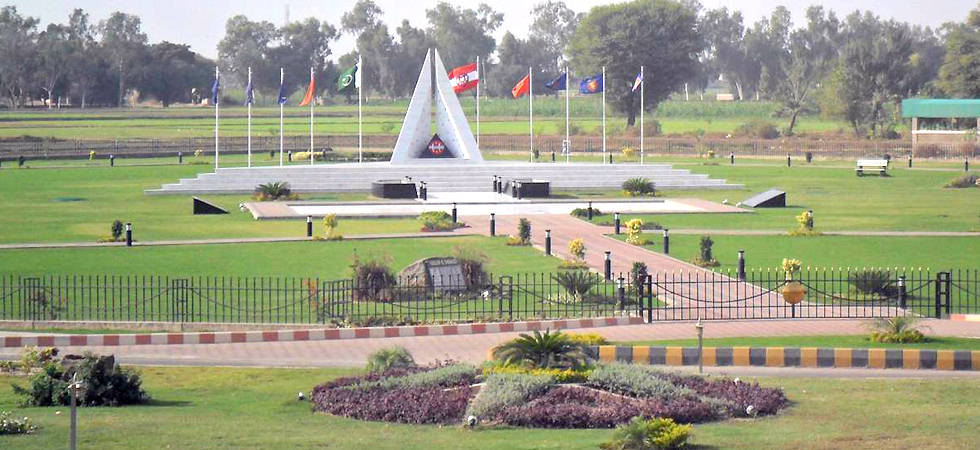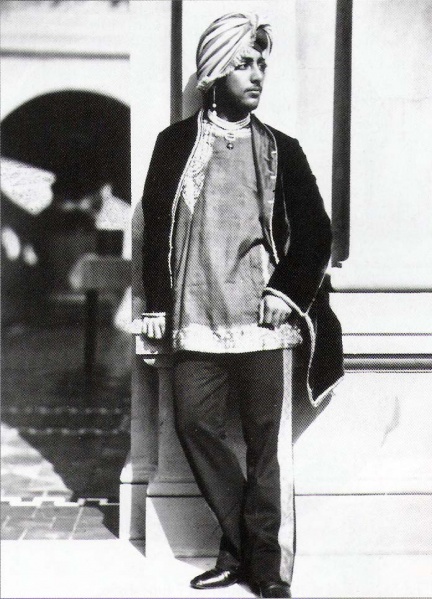|
Bannu Cantonment
Bannu Cantonment is a cantonment adjacent to Bannu in Khyber Pakhtunkhwa, Pakistan. It is the only cantonment in Bannu District and also the only one in the Bannu Division. It has a population of 8,320. History Town of Bannu The town of Bannu was founded in 1848 by Herbert Benjamin Edwardes, a lieutenant in the 1st Bengal European Fusiliers Regiment of the East India Company's private army. The fort, named Dhulipgarh (Dalipgarh) in honour of the Maharajah of Lahore, was constructed at the same time. Originally named Dhulipnagar (Dalipnagar), the town was later renamed to Edwardesabad in 1869 before receiving its current name in 1903. District Bannu Bannu was recorded as a district in 1861 during the British Raj. The district is situated 190 km to the south of Peshawar and shares borders with North Waziristan, Karak, Lakki Marwat, and South Waziristan. The district covers an area of approximately 1,227 square kilometers and has a population of around 1.4 million people. Bannu ... [...More Info...] [...Related Items...] OR: [Wikipedia] [Google] [Baidu] |
Cantonment
A cantonment (, , or ) is a military quarters. In Bangladesh, India and other parts of South Asia, a ''cantonment'' refers to a permanent military station (a term from the colonial-era). In United States military parlance, a cantonment is, essentially, "a permanent residential section (i.e. barrack) of a fort or other military installation," such as Fort Hood. The word ''cantonment'', derived from the French word '' canton'', meaning ''corner'' or ''district'', refers to a temporary military or winter encampment. For example, at the start of the Waterloo campaign in 1815, while the Duke of Wellington's headquarters were in Brussels, most of his Anglo–allied army of 93,000 soldiers were ''cantoned'', or stationed, to the south of Brussels. List of permanent cantonments Afghanistan The former Sherpur Cantonment in Kabul, Afghanistan, which was the site of the Siege of the Sherpur Cantonment (1879) in the Second Anglo-Afghan War (1878–1880), is now maintained as a British Army ... [...More Info...] [...Related Items...] OR: [Wikipedia] [Google] [Baidu] |
Bannu Division
Bannu Division is one of seven divisions in Pakistan's Khyber Pakhtunkhwa province. It consists of three districts: Bannu, Lakki Marwat, and North Waziristan. According to the 2017 Pakistani Census, the division had a population of 2,656,801, making it the least populous division in the province, but it spans of area, and this makes it the third-smallest division by area in the province. Lakki Marwat is the largest city of Bannu Division, with around 60,000 people, while the division's namesake and second-largest city is Bannu, with just under 50,000 people. The division borders Dera Ismail Khan Division to the south and west, Kohat Division to the north and east, and the province of Punjab, Pakistan to its east. Districts Districts are the administrative unit one level below divisions in the administrative hierarchy of Pakistan. Bannu Division consists of the following three districts: History In 1941, the area which today covers the division (excluding North Waz ... [...More Info...] [...Related Items...] OR: [Wikipedia] [Google] [Baidu] |
Survey Of Pakistan
Survey of Pakistan ( ur, ) is the sole national mapping and land surveying government agency of Pakistan. Its head of department is titles as " Surveyor General of Pakistan". About Survey of Pakistan Survey of Pakistan, which emerged as successor to pre-partition Royal Survey of India, is a National Surveying and Mapping Organization of the country. It is primarily responsible for all sorts of topographical land surveys of cis-frontier areas of the entire country. The basic products include map sheets on scale 1:50,000 and 1:250,000. The department is actively participating in the national development projects and thus fulfilling the ever growing surveying and mapping demands of various government / semi-government and autonomous bodies. The geodetic data prepared and maintained by the department is matchless in its accuracy and use. Over the past years, the department has taken a mile stone turn by gradually switching over to surveying and mapping using modern techniques, metho ... [...More Info...] [...Related Items...] OR: [Wikipedia] [Google] [Baidu] |
Punjab Province (British India)
Punjab was a province of British Raj, British India. Most of the Punjab region was annexed by the East India Company in 2 April 1849, and declared a province of British Rule, it was one of the last areas of the Indian subcontinent to fall under British control. In 1858, the Punjab, along with the rest of British India, came under the direct rule of the British Crown. It had an area of 358,354.5 km2. The province comprised four natural geographic regions – ''Indo-Gangetic Plain West'', ''Himalayan'', ''Sub-Himalayan'', and the ''North-West Dry Area'' – along with five administrative divisions – Delhi, Jullundur, Lahore, Multan, and Rawalpindi – and a number of princely states. In 1947, the Partition of India led to the province's division into East Punjab and West Punjab, in the newly independent Dominions of the British Empire, dominions of Dominion of India, India and Dominion of Pakistan, Pakistan respectively. Etymology The region was originally called Sapta S ... [...More Info...] [...Related Items...] OR: [Wikipedia] [Google] [Baidu] |
Sikh Empire
The Sikh Empire was a state originating in the Indian subcontinent, formed under the leadership of Maharaja Ranjit Singh, who established an empire based in the Punjab. The empire existed from 1799, when Maharaja Ranjit Singh captured Lahore, to 1849, when it was defeated and conquered in the Second Anglo-Sikh War. It was forged on the foundations of the Khalsa from a collection of autonomous Sikh '' misls''. At its peak in the 19th century, the Empire extended from the Khyber Pass in the west to western Tibet in the east, and from Mithankot in the south to Kashmir in the north. It was divided into four provinces: Lahore, in Punjab, which became the Sikh capital; Multan, also in Punjab; Peshawar; and Kashmir from 1799 to 1849. Religiously diverse, with an estimated population of 3.5 million in 1831 (making it the 19th most populous country at the time), Amarinder Singh's The Last Sunset: The Rise and Fall of the Lahore Durbar it was the last major region of the Indian s ... [...More Info...] [...Related Items...] OR: [Wikipedia] [Google] [Baidu] |
Cantonment (Pakistan)
Cantonments in Pakistan ( ur, ) are permanent military bases of the Pakistan Army, which are administered by Cantonment Boards under the control of the Military Lands & Cantonments Department (ML&C), Ministry of Defence, Government of Pakistan. Cantonments are established under and governed by the Cantonments Act 1924. In recent times, the demographic character of most independence era cantonments has changed, as they are no longer primarily "garrison" areas, and include significant civilian populations and private businesses. Based on the strength of civil population, the cantonments have been divided into three classes. Class I Cantonments, in which the civil population is one hundred thousand or more; Class II Cantonments, in which the civil population is fifty thousands or more but less than one hundred thousand; and Class III Cantonments, in which the civil population is less than fifty thousand. There are a total of 56 Cantonments in Pakistan. As of 2013, the greatest amou ... [...More Info...] [...Related Items...] OR: [Wikipedia] [Google] [Baidu] |
Peshawar
Peshawar (; ps, پېښور ; hnd, ; ; ur, ) is the sixth most populous city in Pakistan, with a population of over 2.3 million. It is situated in the north-west of the country, close to the International border with Afghanistan. It is the capital of the province of Khyber Pakhtunkhwa, where it is the largest city. Peshawar is primarily populated by Pashtuns, who comprise the second-largest ethnic group in the country. Situated in the Valley of Peshawar, a broad area situated east of the historic Khyber Pass, Peshawar's recorded history dates back to at least 539 BCE, making it one of the oldest cities in South Asia. Peshawer is among the oldest continuously inhabited cities of the country. The area encompassing modern-day Peshawar is mentioned in Vedic scriptures; it served as the capital of the Kushan Empire during the rule of Kanishka and was home to the Kanishka Stupa, which was among the tallest buildings in the ancient world. Peshawar was then ruled by the Hephth ... [...More Info...] [...Related Items...] OR: [Wikipedia] [Google] [Baidu] |
British Raj
The British Raj (; from Hindi language, Hindi ''rāj'': kingdom, realm, state, or empire) was the rule of the British The Crown, Crown on the Indian subcontinent; * * it is also called Crown rule in India, * * * * or Direct rule in India, * Quote: "Mill, who was himself employed by the British East India company from the age of seventeen until the British government assumed direct rule over India in 1858." * * and lasted from 1858 to 1947. * * The region under British control was commonly called India in contemporaneous usage and included areas directly administered by the United Kingdom of Great Britain and Ireland, United Kingdom, which were collectively called Presidencies and provinces of British India, British India, and areas ruled by indigenous rulers, but under British British paramountcy, paramountcy, called the princely states. The region was sometimes called the Indian Empire, though not officially. As ''India'', it was a founding member of the League of Nations, a ... [...More Info...] [...Related Items...] OR: [Wikipedia] [Google] [Baidu] |
Dhulipnagar
Bannu ( ps, بنو, translit=banū ; ur, , translit=bannū̃, ) is a city located on the Kurram River in southern Khyber Pakhtunkhwa, Pakistan. It is the capital of Bannu Division. Bannu's residents are primarily members of the Banuchi tribe and speak Banuchi (Baniswola) dialect of Pashto which is similar to the distinct Waziristani dialect. Total 5 Tehsil in Bannu. The major industries of Bannu are cloth weaving, sugar mills and the manufacturing of cotton fabrics, machinery and equipment. It is famous for its weekly ''Jumma'' fair. The district forms a basin drained by the Kurram and Gambila (or Tochi) rivers. Etymology According to the philologist Michael Witzel, the city was originally known in Avestan as ''Varəna'', from which its modern name derives. The ancient Sanskrit grammarian, Pāṇini, recorded its name as ''Varṇu''. During the 6th century BCE, the basin around Bannu was known as ''Sattagydia'' (Old Persian: 𐎰𐎫𐎦𐎢𐏁 ''Thataguš'', country of t ... [...More Info...] [...Related Items...] OR: [Wikipedia] [Google] [Baidu] |
Duleep Singh
Maharaja Sir Duleep Singh, GCSI (4 September 1838 – 22 October 1893), or Sir Dalip Singh, and later in life nicknamed the "Black Prince of Perthshire", was the last ''Maharaja'' of the Sikh Empire. He was Maharaja Ranjit Singh's youngest son, the only child of Maharani Jind Kaur. He was placed in power in September 1843, at the age of five, with his mother ruling on his behalf, and after their defeat in the Anglo-Sikh War, under a British Resident. He was subsequently deposed by the British Crown, and thereafter exiled to Britain at age 15 where he was befriended by Queen Victoria, who is reported to have written of the Punjabi Maharaja: "Those eyes and those teeth are too beautiful".Eton, the Raj and modern India By Alastair Lawson; 9 March 2005; BBC News. The Queen was godmother to several of his children.< ... [...More Info...] [...Related Items...] OR: [Wikipedia] [Google] [Baidu] |
East India Company
The East India Company (EIC) was an English, and later British, joint-stock company founded in 1600 and dissolved in 1874. It was formed to trade in the Indian Ocean region, initially with the East Indies (the Indian subcontinent and Southeast Asia), and later with East Asia. The company seized control of large parts of the Indian subcontinent, colonised parts of Southeast Asia and Hong Kong. At its peak, the company was the largest corporation in the world. The EIC had its own armed forces in the form of the company's three Presidency armies, totalling about 260,000 soldiers, twice the size of the British army at the time. The operations of the company had a profound effect on the global balance of trade, almost single-handedly reversing the trend of eastward drain of Western bullion, seen since Roman times. Originally chartered as the "Governor and Company of Merchants of London Trading into the East-Indies", the company rose to account for half of the world's trad ... [...More Info...] [...Related Items...] OR: [Wikipedia] [Google] [Baidu] |
Herbert Benjamin Edwardes
Major-General Sir Herbert Benjamin Edwardes DCL (12 November 1819 – 23 December 1868) was a British administrator, soldier, and statesman active in the Punjab region of British India. He is best known as the "Hero of Multan" for his pivotal role in securing British victory in the Second Anglo-Sikh War. Background and early life Edwardes was born at Frodesley in Shropshire on 12 November 1819, the 2nd son of the Rev. Benjamin Edwardes (1790/1-1823), rector of Frodesley, a younger son of Sir John Thomas Cholmondeley Edwardes, 8th Baronet, of Shrewsbury (1764–1816). The Edwardes Baronetcy of Shropshire had been conferred on his ancestor Sir Thomas Edwardes by King Charles I in 1644/5.The baronetcy eventually became dormant on the death of the 10th Baronet Sir Henry Hope Edwardes to extant with Edwardes-Iddon which Edwardes are descended claiming succession to the title. Edwardes's mother died during his infancy, and from the age of four, following his father's death in 182 ... [...More Info...] [...Related Items...] OR: [Wikipedia] [Google] [Baidu] |







